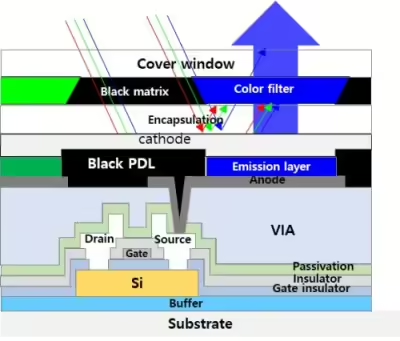What Display Daily thinks: It’s not just power reduction and brightness that drives thinner AMOLEd displays for smartphones. Foldables are strategic imperatives for phone makers and with Samsung committed to maintaining its own lead in the smartphone market with its Z Fold and Z Flip products, there is a growing sense of urgency to find newer, better ways to reduce the thickness of displays.
PDL technology may not create any effective cost reductions but it doesn’t add any of significance either. Apple is unlikely to want to do anything but deliver a foldable product that is inherently thinner and more stylish than the competition, and the competition has a head start.
The news that LG is exploring refined black PDL as a core component of its own designs for foldable designs should create more of a groundswell of interest in using the technology in future panel designs on the heels of what Samsung and BOE have already realized. Companies such as Mitsubishi, Toray, and NS Deolux have constrained supply but they offer a number of paths for display makers to move towards pol-less AMOLED as a standard approach.
There’s a point at which foldables are going to take off, meaning that they will break out of a niche, premium segment into mainstream. Thinner folded devices could be the point where they become indispensable to consumers even with the expected additions of manufacturing costs.
Ironically, the trade-off in power savings may not happen because with reduced power consumption you have to weigh the additional drain on the battery made by bigger screens. So, if consumers get thinner profiles when they shove a folder phone in their pockets – and the battery drain doesn’t change perceptibly with the larger, unfolded screen – we might be talking exclusively about upgrade cycles in smartphones being driven solely by foldable feature sets by the end of 2025. Right now, the main driver is camera technology and form factor. GenAI smartphones are adding to the benefits by providing AI-enhanced image processing, but it hasn’t necessarily changed the growth of the market or dampened consumers’ desire to hold on to their old phones much longer. Foldables are the game changer and they can’t become more ubiquitous soon enough for the industry.
Pol-Less AMOLED
The development and use of Pixel Define Layer (PDL) technology in displays, particularly for OLED panels, has evolved significantly over the past few years, with advances in reducing display thickness and improving efficiency.
Back in early 2021, Samsung Display introduced polorizer-less OLEDs, which were a part of its broader efforts to eliminate the need for polarizers in AMOLED displays. The traditional circular polarizer, though effective in reducing reflection, added to the thickness of the display and diminished brightness. By replacing the polarizer with a thin color filter structure and incorporating a black PDL, Samsung aimed to significantly reduce display thickness by around 20% and enhance brightness. The black PDL, a relatively new development at that time, played a crucial role in absorbing any light that passed through the color filter, thus improving the reflectivity ratio without the need for additional anti-reflective films. However, the transition to this new structure introduced complexity in the manufacturing process, requiring additional photolithography steps, which posed challenges in yield rates and viewing angles.

By late 2022, the use of PDL technology had expanded, with both Samsung Display and BOE introducing pol-less display technologies as cost-effective alternatives to the existing Color Filter on Encapsulation (COE) structures. The low-cost pol-less technology focused on removing the color filter (CF) and black matrix (BM) layers and replacing the over-coating (OC) layer with a material of lower transparency. This innovation not only reduced the need for photomasks but also simplified the manufacturing process, thereby lowering production costs. However, this cost-saving approach came with trade-offs, such as a reduction in power-saving efficiency and a potential increase in reflectivity, which could affect the overall display performance.
Thsi week, LG Display further refined the use of black PDL technology, particularly in the context of foldable OLED panels. Testing samples from multiple suppliers, including Mitsubishi, LG aims to use black PDL as a core component of COE technology to create thinner, more efficient foldable displays. The shift from the traditional orange-based PDL material to a black-based material was essential in reducing light reflection and improving contrast, especially in foldable panels where durability and power consumption are critical concerns.

